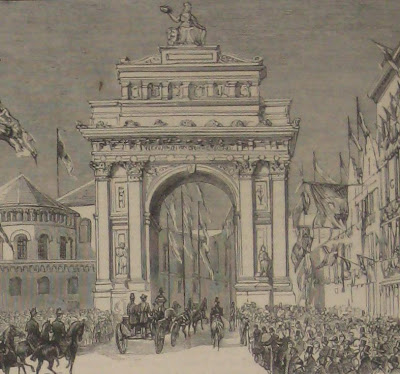 While cities like Paris, London, St Petersburg and Milan have several each, Oslo is not among the capitals provided with a triumphal arch or gate. This is probably because of the lack of any great triumphs to commemorate, but there have been a number of temporary triumphal arches in Oslo, most of them erected in connection with royal events.
While cities like Paris, London, St Petersburg and Milan have several each, Oslo is not among the capitals provided with a triumphal arch or gate. This is probably because of the lack of any great triumphs to commemorate, but there have been a number of temporary triumphal arches in Oslo, most of them erected in connection with royal events.The second half of the 19th century was the age of temporary monuments – in Oslo can be mentioned a monument to the Swedish-Norwegian union outside the Royal Palace on the occasion of its jubilee in 1864, a monument to King Harald the Fair-haired when the supposed millennium of Norway’s unification was celebrated in 1872 and the triumphal arch in Eger Square built to welcome the newlywed Crown Princess Victoria in 1882. The latter was designed by Georg Andreas Bull and the sculptures of ancient Norwegian kings were made by Brynjulf Bergslien.
Princess Victoria of Baden and Crown Prince Gustaf of Norway and Sweden had married in her hometown Karlsruhe in September 1881 and made their triumphal entry into the Norwegian capital in February 1882. Karl Johan’s Street from Eger Square to the Royal Palace was festively decorated, but the welcome was not really a warm one. Victoria was never to like Norway much and, for a militant antidemocrat like her, she arrived at almost the worst possible moment.
The Norwegian monarchy was in the middle of one of its most severe crises, which ended with the impeachment of the Selmer ministry and the introduction of parliamentarianism in 1884. This signalled the end of the King’s political powers, but the endgame would last for another 21 years.
During the next great crisis, in 1895, Crown Princess Victoria was among the warmongers, eagerly supported by her cousin, Emperor Wilhelm II. Even after the peaceful dissolution of the union in 1905, it rankled deeply with Victoria, according to her brother-in-law Prince Carl, that “the revolution in Kristiania had not been suppressed by the force of weapons”.
When her husband, as King Gustaf V, was to visit Norway in 1917, it was made quite clear to him that he was expected to come without his wife. The official explanation was that there would not be room in the Royal Palace for Queen Victoria and her retinue. No problem, said the Swedes, the Queen could stay in her own railway carriage. Thanks, but no thanks, replied the Norwegians.
Had she come, there would have been no triumphal arch to welcome her. The arch of 1882 was dismantled when the festivities were over and for nearly 130 years there was not a trace of it. But last year a new shopping centre opened at Eger Square and just inside the entrance an entire wall is covered with a photo of the triumphal arch. The illustration above is taken from The Graphic, 4 March 1882.





No comments:
Post a Comment
Comments are welcome, but should be signed - preferably by a name, but an initial or a nick will also be accepted. Advertisements are not allowed. COMMENTS WHICH DO NOT COMPLY WITH THESE RULES WILL NOT BE PUBLISHED.